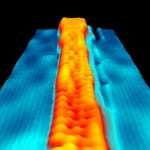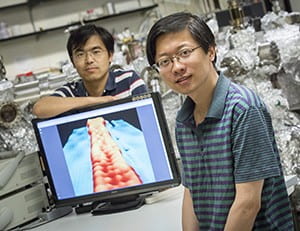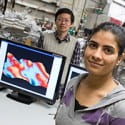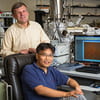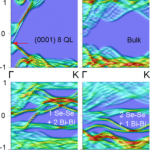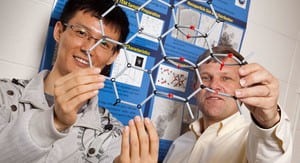Links to
UWM & Other
Collaborators:
Lian Li (WVU)
Agterberg
Tysoe
Gajdardziska-Josifovska
Hirschmugl
Schneider (Oregon State)
Redinger (TU Wien)
Lazarov (York)
Research Overview
The main research thrusts are:
- The investigation of the electronic, magnetic, and structural properties of complex materials – surfaces, interfaces, alloys, and nanostructured systems – from first-principles, with an emphasis on phase stability, defects, transport, and nanostructures.
- The analysis and interpretation of experiments involving surface scanning probes (scanning tunneling and atomic force microscopies), spectroscopies (e.g., photoemission, Auger, x-ray absorption, and STS), and electron microscopy.
- The development and use of advanced first-principles electronic structure methods to model and understand the properties of materials.
Much of our research is done in collaboration with experimentalists; in particular, we have a number of joint projects (and grants) with Prof. Lian Li’s group (now at West Virginia). Our research is funded by the National Science Foundation and the Department of Energy.
Selected Topics
Our research interests cover a broad range of topics in condensed matter physics and materials science. Some of these are briefly described below; since it is likely that this list will be (or already is) out of date, the list of publications may provide a better indication of our research.
Topological Insulators
The unique surface properties of topological insulators (TI) provide a playground to investigate plethora of novel physics. Some of the questions we are addressing through our joint experiment/theory collaboration include: How much “bulk” is needed to form a TI? How to tune material parameters to go from trivial to TI? How robust are TIs, i.e., can they be destroyed? How do native defects such as grain boundaries affect TIs? How do the intrinsic material properties (e.g., “aging”) of the TIs limit their usefulness and how can this be mitigated?
Graphene – Defects and growth
Graphene continues to be a topic of intense interest world-wide. Our focus is on the structural and electronic effects due to defects, impurities, and interfaces with other materials, as well as growth. By combining calculations and experiments (e.g., STM, AFM, STS), we aim to obtain atomic-scale information (and understanding) of graphene and graphene-based materials.
Surface Structures
The structure of surfaces, overlayers, and interfaces remain a challenging – and interesting – problem. Many systems, even nominally simple metals, can have quite complicated surface/interface orderings when combined. To disentangle the competing interactions, both experiment and theory are necessary, with calculations providing essential insights into the underlying physics governing the reconstructions.
Graphene-Oxide Materials
In the search for semiconducting graphene-based materials, graphene oxide is especially promising. The reported ordered 1:1::C:O material, graphene mono-oxide (GMO), has particularly appealing properties related to the predicted tunability of its band gap. Questions regarding the growth, stability, its interfaces with graphene and other materials, and how it can be incorporated into actual devices are being investigated.
Electric-field Effects
Understanding how external applied electric fields affect the electronic and magnetic properties of oxides and metals is essential for the successful development of nanoscale electronics. We are using first-principles calculations that explicitly include the external field as a means to address the underlying physics at the atomic scale, as well as addressing questions of how well DFT in it usual GGA/LDA incarnations is able to describe the response (polarizability) to external fields.
Polar Oxides
Issues related to the stability and growth of polar oxide surfaces have been controversial for many years. We have been interested in the properties of the clean surfaces and also oxide-oxide, oxide-semiconductor, and oxide-metal interfaces, especially the energetics and structural changes during layer-by-layer growth.
Antiferromagnetic Semiconductors
In the search for new spintronic materials, we considered anti-ferromagnetic semiconductors. We investigated, both experimentally and theoretically, the feasibility of producing spin-polarized carriers and magnetic moments in the semiconducting AFM background by selectively substituting the magnetic element in a sublattice by defects or impurities.
Sliding Boundary-layer Friction
In collaboration with Tysoe, we have investigated the (pressure-dependent) shear strength and related properties of boundary layer films on metal surfaces using DFT calculations. We have focused our attention on questions such as whether calculations are at all able to accurately reproduce the experimental values and trends, how and where shear occurs, and how to relate the atomic-scale frictional properties to the macroscopic experimental measurements.
Code development
As one of the original developers of the Full-potential Linearized Augmented Plane Wave (FLAPW) method, development of electronic structure codes has been – and remains – an important research objective. In addition to the FLAPW codes, I have been involved in the development of a full-potential KKR Green’s function code, the Linearized Augmented Slater-type Orbital (LASTO) method, and a plane wave pseudopotential code (BEST). The main development effort currently is on the FLAPW code flair. A symmetry program, symgen, is also available and is included in flair.
